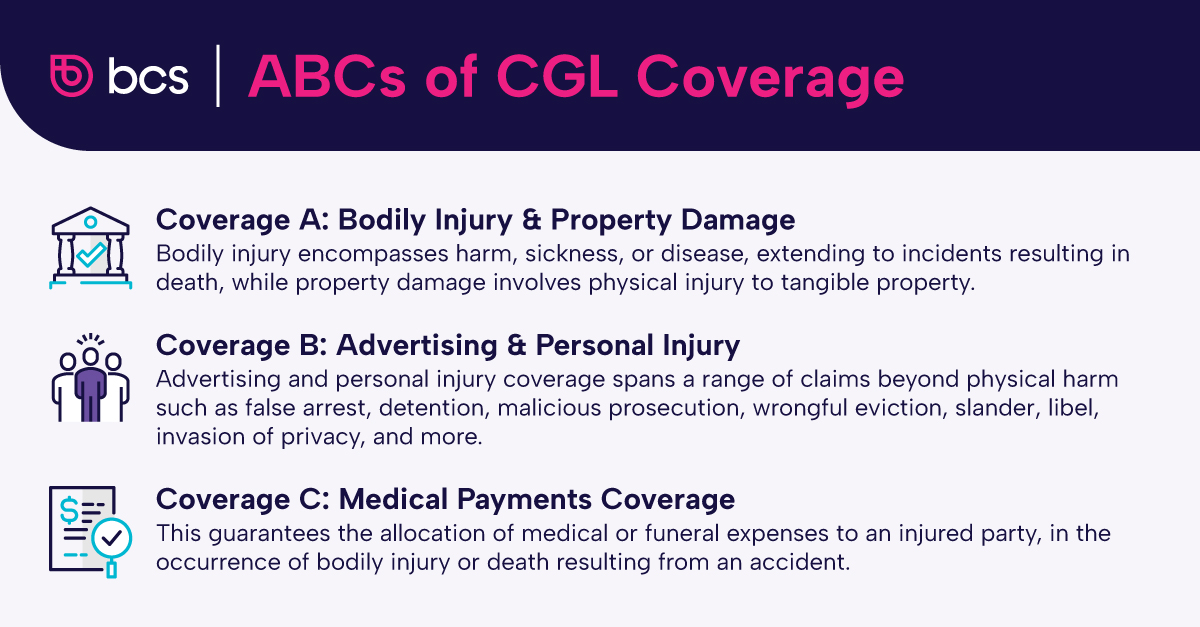
What Is Commercial General Liability?
While every third-party partnership carries inherent risks, ensuring all parties involved have the appropriate commercial general liability (CGL) policies and endorsements helps mitigate liabilities and maintain compliance.
CGL policies provide coverage in the event of any non-professional negligence resulting in bodily harm, property damage, and other workplace injuries.
This guide outlines the basics of these policies, coverage types, and differences between professional and general liability so you can mitigate risks and create safer partnerships.
Key Takeaways
- Commercial General Liability (CGL) insurance serves as a primary defense against losses, offering broad protection across various incidents.
- CGL coverage is categorized into bodily injury and property damage, advertising and personal injury, and medical payments, each addressing specific aspects of potential liabilities.
- These policies come in two forms, occurrence and claims-made, with differences in coverage periods and reporting timelines.
What Is Commercial General Liability (CGL)?
Introduced in 1986 to replace the comprehensive general liability policy, commercial general liability (CGL) protects a business from instances of non-professional negligence.
In the event of property damage, bodily harm, or other injuries, these policies cover any resulting liability claims.
Watch: Commercial General Liability Insurance Basics
“The Commercial General Liability, also known as the CGL, is one of the most important types of insurance as it is the first line of defense in the event of a loss. In fact, it is the broadest in terms of types of incidents it will protect the company against. In this video, we will talk about the Commercial General Liability policy and its limits.”
ABCs of CGL Coverage
There are three groups of CGL policies aptly referred to as Coverage A, B, and C in the insurance world.
Here's a breakdown:
Coverage A: Bodily Injury & Property Damage
Bodily injury typically includes bodily harm, sickness, or disease, including incidents resulting in death.
Example: A painter is working on a building and falls off his ladder, resulting in a bodily injury claim.
Property damage refers to the coverage available if the policyholder is negligent in causing damage to the specific space that they are renting. As it pertains to general liability, this is defined by the educational service International Risk Management Institute (IRMI) as “physical injury to tangible property including resulting loss of use and loss of use of tangible property that has not been physically injured.”
Example: A painter's ladder falls over and shatters a window, resulting in a property damage claim.
This also includes Products and Completed Operations coverage, which is available when the policyholder is negligent in causing injury to a third party once their work is finished or once a third party has possession of and use of the products. This coverage has a separate limit subject to its own aggregate limit compared to the general aggregate which covers premises and operations exposures.
Coverage B: Advertising & Personal Injury
Under general liability, combined in standard CGL policies, advertising and personal injury constitute a category of insurable offenses that produce harm other than bodily injury.
Examples: This can cover claims including false arrest, detention, or imprisonment; malicious prosecution; wrongful eviction; slander; libel; invasion of privacy; copyright infringement; and misappropriation of advertising ideas.
Coverage C: Medical Payments Coverage
This ensures medical or funeral expenses are allocated to an injured party—regardless of liability—in the event of bodily injury or death from an accident under specified conditions.
Medical expense limits lay out how much the policy will pay for reasonable medical costs for bodily injury caused by an accident without regard to fault. This is subject to the limit of the policy. It applies separately to each injured person, but will reduce the “each occurrence” or “general aggregate limit” each time.
Note: Other types of liability policies include liquor liability, directors and officers liability, and pollution liability. An insurance professional can help determine the right endorsements for your business.

What Are the Types of CGL Coverage?
CGL coverage comes in two forms, occurrence and claims-made, each addressing different aspects of business risks.
Occurrence
An occurrence policy protects a business from any covered incident during the policy period, regardless of when a claim arises. This type of insurance will cover a business even if the claim comes in after the policy is canceled, as long as the incident occurred within the time frame dictated by the initial policy.
Claims-Made
A claims-made policy provides coverage for claims occurring and reported within the specified period set forth by the terms and conditions. If the policy is canceled or the premium isn't paid, claims filed will not be covered, even if the incident occurred when the policy was active.
What Is the General Aggregate?
General Aggregate is the total amount the policy must pay in any policy term. This is subject to the “Per Occurrence” limit, meaning the policy will only pay up to the “Each Occurrence” limit for each claim, so long as it is less than or equal to the General Aggregate limit.
The General Aggregate can respond in three ways:
- Per Policy
- Per Project
- Per Location
What Is the Difference Between Professional & General Liability?
General liability involves non-professional negligence. Instances of professional negligence are covered under professional liability policies.
Professional negligence is most applicable within industries with codes of conduct or standards for your services.
As a rule of thumb, general liability insurance typically covers physical damage to your business, whereas professional liability insurance—also called errors and omissions (E&O) insurance—often concerns libel, slander, misrepresentation, negligence, and inaccurate advice.
Hot Tip!
Depending on the nature of your business, an insurance broker may advise you to purchase both general and professional liability policies. If you decide to use two different carriers and a claim is made against your business, one insurance company may try to foist responsibility for the payout onto the other. To avoid this competition and encourage focusing on the problem at hand, purchase both from the same insurance carrier.
bcs: Streamlining Your Vendor Management Process
Ensuring all involved in third-party partnerships hold the essential policies and endorsements can shield your company from unnecessary risk exposures.
To streamline compliance and mitigate liability, bcs offers full- and self-service COI tracking options to collect, review, and correct documents in real time.
From automated RFP broadcasting and in-app onboarding to instant COI deficiency alerts, our solution simplifies every facet of vendor management.
By securely managing documents, communication, and COI tracking all in one place, you can get back to focusing on running your business.
bcs is a leading vendor management solution providing full- and self-service COI tracking, document maintenance, and so much more. To learn more about streamlining your vendor management processes, schedule a demo today.
Subscribe Now
Learn from the pros about risk-mitigation, document tracking, and more, with expert articles from bcs.





Leave a comment